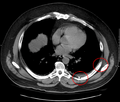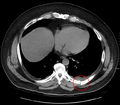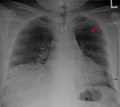Rib fracture
| Rib fracture | |
|---|---|
 An X ray showing multiple old fractured ribs of the person's left side as marked by the oval. | |
| Classification and external resources | |
| ICD-10 | S22.3-S22.4 |
| ICD-9 | 807.0, 807.1 |
| DiseasesDB | 11553 |
| eMedicine | emerg/204 radio/609 |
| MeSH | D012253 |
A rib fracture is a break or fracture in one or more of the bones making up the rib cage. The first rib is rarely fractured because of its protected position behind the clavicle (collarbone). However, if it is broken, serious damage can occur to the brachial plexus of nerves and the subclavian vessels. Fractures of the first and second ribs may be more likely to be associated with head and facial injuries than other rib fractures. The middle ribs are the ones most commonly fractured. Fractures usually occur from direct blows or from indirect crushing injuries. The weakest part of a rib is just anterior to its angle, but a fracture can occur anywhere. The most commonly fractured ribs are the 7th and 10th. A lower rib fracture has the complication of potentially injuring the diaphragm, which could result in a diaphragmatic hernia. Rib fractures are usually quite painful because the ribs have to move to allow for breathing. When several ribs are broken in several places a flail chest results, and the detached bone sections will move separately from the rest of the chest.
Causes
Rib fractures can occur without direct trauma and have been reported after sustained coughing and in various sports – for example, rowing, karting and golf – often in elite athletes. They can also occur as a consequence of diseases such as cancer or infections (pathological fracture).
Fragility fractures of ribs can occur due to diseased bone structure, e.g. osteoporosis and metastatic deposits.
Diagnosis
Broken ribs are often indicated by the following symptoms:
- Pain when breathing or with movement
- A portion of the chest wall moving separately from the rest of the chest (flail chest)
- A grating sound with breathing or movement
- Where the mechanism of injury would indicate substantial force to the ribs
Because children have more flexible chest walls than adults do, their ribs are more likely to bend than to break; therefore the presence of rib fractures in children is evidence of a significant amount of force and may indicate severe thoracic injuries such as pulmonary contusion.[1] Rib fractures are also a sign of more serious injury in elderly people.[1]
-

Rib fractures
-

Rib fractures
-

Rib fractures
-

Rib fractures
-

Rib fractures as seen on plain X ray
Treatment
There is no specific treatment for rib fractures, but various supportive measures can be taken. In simple rib fractures, pain can lead to reduced movement and cough suppression; this can contribute to formation of secondary chest infection. Adequate analgesia can avoid this.
Flail chest is a potentially life-threatening injury and will often require a period of assisted ventilation. Flail chest and first rib fractures are high-energy injuries and should prompt investigation of damage to underlying viscera (e.g., lung contusion) or remotely (e.g., cervical spine injury).
Spontaneous fractures in athletes generally require a cessation of the cause, e.g., time off rowing, while maintaining cardiovascular fitness.
Treatment options for internal fixation/repair of rib fractures include:
- Acute Innovations RibLoc is a titanium U-shaped plate that is sized to match rib thickness and uses screws that fixate to anterior and posterior of plate and provide fixation without needing bone purchase for screws and without risking damage to the neurovascular bundle. These plates can be contoured to match the rib segment being plated and come in various lengths.
- Judet and/or Sanchez Plates/Struts are a metal plate with strips that bend around the rib and then is further secured with sutures.
- Synthes MatrixRIB Fixation System has two options: a precontoured metal plate that uses screws to secure the plate to the rib; and/or an intramedullary splint which is tunneled into the rib and secured with a set screw.
- Anterior locking plate are metal plates that have holes for screws throughout the plate. The plate is positioned over the rib and screwed into the bone at the desired position. The plates may be bent to match the contour of the rib section.
See also
References
- ↑ 1.0 1.1 Wanek S, Mayberry JC (January 2004). "Blunt thoracic trauma: Flail chest, pulmonary contusion, and blast injury". Critical Care Clinics 20 (1): 71–81. doi:10.1016/S0749-0704(03)00098-8. PMID 14979330.
| ||||||||||||||||||||||||||||||||||||||||||||||||||||||||||||||||||||||||||||||||||||||||||||||||||
| ||||||||||||||||||||||||||||||||||||||||||||||||||||||||